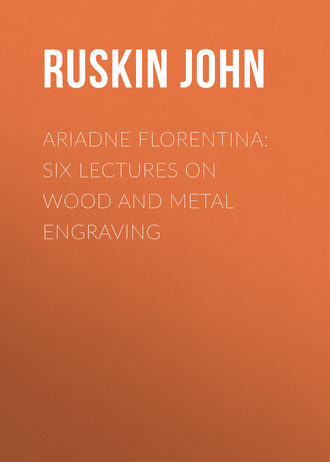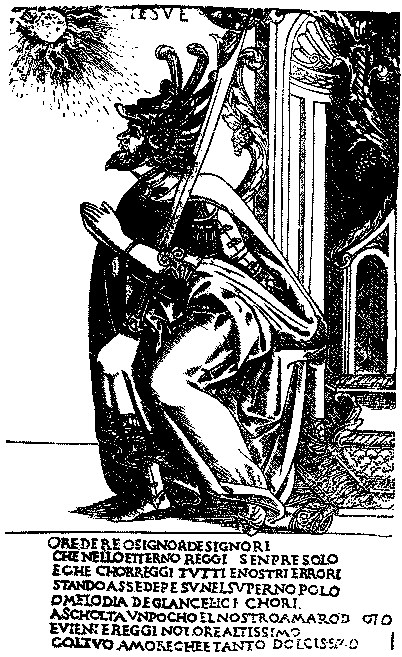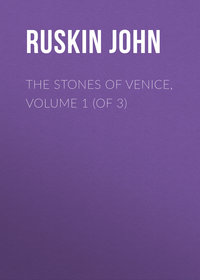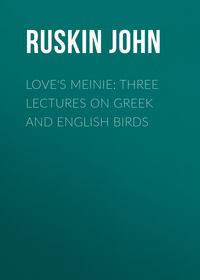 полная версия
полная версияAriadne Florentina: Six Lectures on Wood and Metal Engraving
I have added this note to the lecture in copying my memoranda of it here at Assisi, June 9th, being about to begin work in the Tavern, or Tabernaculum, of the Lower Church, with its variously significant four great 'signs.'
33
Plate X., Lecture VI.
34
I do not mean the greatest teacher of reformed faith; but the greatest protestant against faith unreformed.
35
It has become the permitted fashion among modern mathematicians, chemists, and apothecaries, to call themselves 'scientific men,' as opposed to theologians, poets, and artists. They know their sphere to be a separate one; but their ridiculous notion of its being a peculiarly scientific one ought not to be allowed in our Universities. There is a science of Morals, a science of History, a science of Grammar, a science of Music, and a science of Painting; and all these are quite beyond comparison higher fields for human intellect, and require accuracies of intenser observation, than either chemistry, electricity, or geology.
36
The Cumaean Sibyl, Plate VII., Lecture VI.
37
Lecture III., § 101.
38
I read somewhere, lately, a new and very ingenious theory about the attitude of the Apollo Belvedere, proving, to the author's satisfaction, that the received notion about watching the arrow was all a mistake. The paper proved, at all events, one thing—namely, the statement in the text. For an attitude which has been always hitherto taken to mean one thing, and is plausibly asserted now to mean another, must be in itself unintelligible.
39
It may be asked, why not corn also? Because that belongs to Ceres, who is equally one of the great gods.
40
"Aratra Pentelici," § 181.
41
Or inventive! See Woltmann, p. 267. "The shinbone, or the lower part of the arm, exhibits only one bone, while the upper arm and thigh are often allowed the luxury of two!"
42
See ante, § 141. The "preface" is that to "The Eagle's Nest."
43
The drawings were made by Turner, and are now among the chief treasures of the Oxford Galleries. I ought to add some notice of Hogarth to this lecture in the Appendix; but fear I shall have no time: besides, though I have profound respect for Hogarth, as, in literature, I have for Fielding, I can't criticise them, because I know nothing of their subjects.
44
The world was not then ready for Le Père Hyacinthe;—but the real gist of the matter is that Lippi did, openly and bravely, what the highest prelates in the Church did basely and in secret; also he loved, where they only lusted; and he has been proclaimed therefore by them—and too foolishly believed by us—to have been a shameful person. Of his true life, and the colors given to it, we will try to learn something tenable, before we end our work in Florence.
45
I insert supplementary notes, when of importance, in the text of the lecture, for the convenience of the general reader.
46
Mr. Charles F. Murray.
47
Some notice of this picture is given at the beginning of my third Morning in Florence, 'Before the Soldan.'
48
I am bitterly sorry for the pain which my partial references to the man whom of all English artists whose histories I have read, I most esteem, have given to one remaining member of his family. I hope my meaning may be better understood after she has seen the close of this lecture.
49
Read Ezekiel xviii.
50
See also the account by Dr. Woltmann of the picture of the Triumph of Riches. 'Holbein and his Time,' p. 352.
51
These words are engraved in the plate, as spoken by the Virgin.
52
Cosimo Rosselli, especially chosen by the Pope for his gay coloring.
53
I am not certain of their order at this distance of time.
54
Callimachus, 'Delos,' 304, etc.
55
In the Old King's Arms Hotel, Lancaster.
56
A manufacturer wrote to me the other day, "We don't want to make smoke!" Who said they did?—a hired murderer does not want to commit murder, but does it for sufficient motive. (Even our shipowners don't want to drown their sailors; they will only do it for sufficient motive.) If the dirty creatures did want to make smoke, there would be more excuse for them: and that they are not clever enough to consume it, is no praise to them. A man who can't help his hiccough leaves the room: why do they not leave the England they pollute?
57
I know no drawing so subtle as Bewick's, since the fifteenth century, except Holbein's and Turner's. I have been greatly surprised lately by the exquisite water-color work in some of Stothard's smaller vignettes; but he cannot set the line like Turner or Bewick.
58
Gilbert Gray, bookbinder. I have to correct the inaccurate—and very harmfully inaccurate, expression which I used of Bewick, in Love's Meinie (§ 3), 'a printer's lad at Newcastle.' His first master was a goldsmith and engraver, else he could never have been an artist. I am very heartily glad to make this correction, which establishes another link of relation between Bewick and Botticelli; but my error was partly caused by the impression which the above description of his "most invaluable friend" made on me, when I first read it.
Much else that I meant to correct, or promised to explain, in this lecture, must be deferred to the Appendix; the superiority of the Tuscan to the Greek Aphrodite I may perhaps, even at last, leave the reader to admit or deny as he pleases, having more important matters of debate on hand. But as I mean only to play with Proserpina during the spring, I will here briefly anticipate a statement I mean in the Appendix to enforce, namely, of the extreme value of colored copies by hand, of paintings whose excellence greatly consists in color, as auxiliary to engravings of them. The prices now given without hesitation for nearly worthless original drawings by fifth-rate artists, would obtain for the misguided buyers, in something like a proportion of ten to one, most precious copies of drawings which can only be represented at all in engraving by entire alteration of their treatment, and abandonment of their finest purposes. I feel this so strongly that I have given my best attention, during upwards of ten years, to train a copyist to perfect fidelity in rendering the work of Turner; and having now succeeded in enabling him to produce facsimiles so close as to look like replicas, facsimiles which I must sign with my own name and his, in the very work of them, to prevent their being sold for real Turner vignettes, I can obtain no custom for him, and am obliged to leave him to make his bread by any power of captivation his original sketches may possess in the eyes of a public which maintains a nation of copyists in Rome, but is content with black and white renderings of great English art; though there is scarcely one cultivated English gentleman or lady who has not been twenty times in the Vatican, for once that they have been in the National Gallery.
59
"Would not the design have looked better, to us, on the plate than on the print? On the plate, the reins would be in the left hand; and the whole movement be from the left to the right? The two different forms that the radiance takes would symbolize respectively heat and light, would they not?"
60
Strutt, pp. 97-8, ed. 1801.
61
Explained as "a game still played by the shepherds, cowkeepers," etc., in the midland counties.
62
See Iliad, 20, 145.

XI.
"Obediente Domino voci hominis."
63
See note to the close of this article, p. 156.
64
The raven, however, like all Dickens's animals, is perfect: and I am the more angry with the rest because I have every now and then to open the book to look for him.
65
"Laws of Fésole."
66
2, Church Terrace, Richmond, Surrey. Note.—I have hitherto permitted Mr. Ward to copy any Turner drawing he was asked to do; but, finding there is a run upon the vignettes of Loch Lomond and Derwent, I have forbidden him to do more of them for the present, lest his work should get the least mechanical. The admirable drawings of Venice, by my good assistant, Mr. Bunney, resident there, will become of more value to their purchasers every year, as the buildings from which they are made are destroyed. I was but just in time, working with him at Verona, to catch record of Fra Giocondo's work in the smaller square; the most beautiful Renaissance design in North Italy.
67
The engraving of Turner's "Scene on the Rhine" (near Bingen?) with boats on the right, and reedy foreground on the left; the opening between its mountain banks in central distance. It is exquisitely engraved, the plate being of the size of the drawing, about ten inches by six, and finished with extreme care and feeling.
68
See the horrible picture of St. Sebastian by him in our own National Gallery.
69
See "The Eagle's Nest," § 79.
70
As in the muscles of the legs and effort in stretching bows, of the executioners, in the picture just referred to.
71
Observe, I entirely distinguish the study of anatomy—i.e., of intense bone and muscle—from study of the nude, as the Greeks practiced it. This for an entirely great painter is absolutely necessary; but yet I believe, in the case of Botticelli, it was nobly restricted. The following note by Mr. Tyrwhitt contains, I think, the probable truth:—
"The facts relating to Sandro Botticelli's models, or rather to his favorite model (as it appears to me), are but few; and it is greatly to be regretted that his pictures are seldom dated;—if it were certain in what order they appeared, what follows here might approach moral certainty.
"There is no doubt that he had great personal regard for Fra Filippo, up to that painter's death in 1469, Sandro being then twenty-two years old. He may probably have got only good from him; anyhow he would get a strong turn for Realism,—i.e. the treatment of sacred and all other subjects in a realistic manner. He is described in Crowe and Cavalcaselle from Filippino Lippi's Martyrdom of St. Peter, as a sullen and sensual man, with beetle brows, large fleshy mouth, etc., etc. Probably he was a strong man, and intense in physical and intellectual habit.
"This man, then, begins to paint in his strength, with conviction—rather happy and innocent than not—that it is right to paint any beautiful thing, and best to paint the most beautiful,—say in 1470, at twenty-three years of age. The allegorical Spring and the Graces, and the Aphrodite now in the Ufficii, were painted for Cosmo, and seem to be taken by Vasari and others as early, or early-central, works in his life: also the portrait of Simonetta Vespucei72. He is known to have painted much in early life for the Vespucei and the Medici;—and this daughter of the former house seems to have been inamorata or mistress of Giuliano de' Medici, murdered by the Pazzi in 1478. Now it seems agreed by Crowe and Cavalcaselle, Pater, etc., (and I am quite sure of it myself as to the pictures mentioned)—first, that the same slender and long-throated model appears in Spring, the Aphrodite, Calumny, and other works.73 Secondly, that she was Simonetta, the original of the Pitti portrait.
"Now I think she must have been induced to let Sandro draw from her whole person undraped, more or less; and that he must have done so as such a man probably would, in strict honor as to deed, word, and definite thought, but under occasional accesses of passion of which he said nothing, and which in all probability and by grace of God refined down to nil, or nearly so, as he got accustomed to look in honor at so beautiful a thing. (He may have left off the undraped after her death.) First, her figure is absolutely fine Gothic; I don't think any antique is so slender. Secondly, she has the sad, passionate, and exquisite Lombard mouth. Thirdly, her limbs shrink together, and she seems not quite to have 'liked it' or been an accustomed model. Fourthly, there is tradition, giving her name to all those forms.
"Her lover Giuliano was murdered in 1478, and Savonarola hanged and burnt in 1498. Now, can her distress, and Savonarola's preaching, between them, have taken, in few years, all the carnality out of Sandro, supposing him to have come already, by seventy-eight, to that state in which the sight of her delighted him, without provoking ulterior feelings? All decent men accustomed to draw from the nude tell us they get to that.
"Sandro's Dante is dated as published in 1482. He may have been saddening by that time, and weary of beauty, pure or mixed;—though he went on painting Madonnas, I fancy. (Can Simonetta be traced in any of them? I think not. The Sistine paintings extend from 1481 to 1484, however. I cannot help thinking Zipporah is impressed with her.) After Savonarola's death, Sandro must have lost heart, and gone into Dante altogether. Most ways in literature and art lead to Dante; and this question about the nude and the purity of Botticelli is no exception to the rule.
"Now in the Purgatorio, Lust is the last sin of which we are to be made pure, and it has to be burnt out of us; being itself as searching as fire, as smoldering, devouring, and all that. Corruptio: optimi pessima; and it is the most searching and lasting of evils, because it really is a corruption attendant on true Love, which is eternal—whatever the word means. That this is so, seems to me to demonstrate the truth of the Fall of Man from the condition of moral very-goodness in God's sight. And I think that Dante connected the purifying pains of his intermediate state with actual sufferings in this life, working out repentance,—in himself and others. And the 'torment' of this passion, to the repentant or resisting, or purity-seeking soul is decidedly like the pain of physical burning.
"Further, its casuistry is impracticable; because the more you stir the said 'fire' the stronger hold it takes. Therefore, men and women are rightly secret about it, and detailed confessions unadvisable. Much talk about 'hypocrisy' in this matter is quite wrong and unjust. Then, its connection with female beauty, as a cause of love between man and woman, seems to me to be the inextricable nodus of the Fall, the here inseparable mixture of good and evil, till soul and body are parted. For the sense of seen Beauty is the awakening of Love, at whatever distance from any kind of return or sympathy—as with a rose, or what not. Sandro may be the man who has gone nearest to the right separation of Delight from Desire: supposing that he began with religion and a straight conscience; saw lovingly the error of Fra Filippo's way; saw with intense distant love the error of Simonetta's; and reflected on Florence and its way, and drew nearer and nearer to Savonarola, being yet too big a man for asceticism; and finally wearied of all things and sunk into poverty and peace."
72
Pitti, Stanza di Prometeo, 348.
73
I think Zipporah may be a remembrance of her.
1
Miller's large plate of the Grand Canal, Venice, after Turner; and Goodall's, of Tivoli, after Turner. The other examples referred to are left in the University Galleries.
1
Miller's large plate of the Grand Canal, Venice, after Turner; and Goodall's, of Tivoli, after Turner. The other examples referred to are left in the University Galleries.











